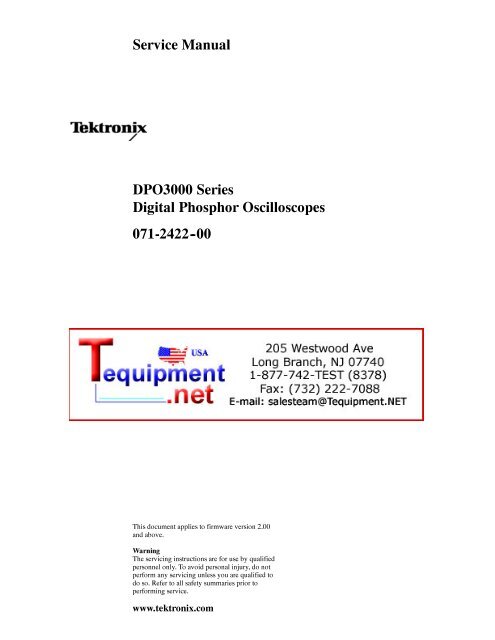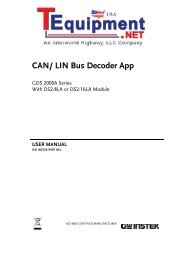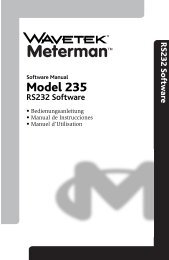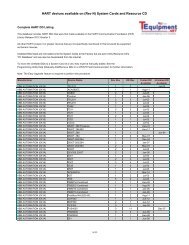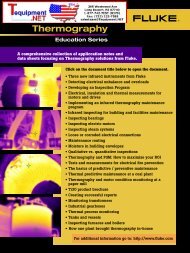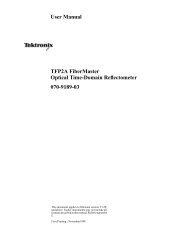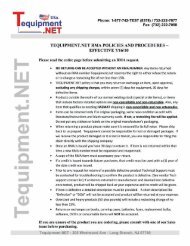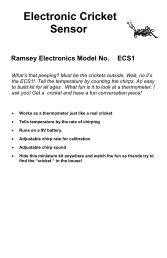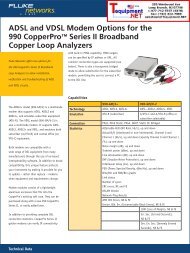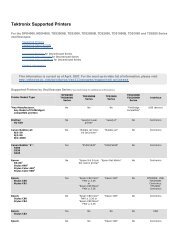DPO3000 Series Digital Phosphor Oscilloscopes ... - Tequipment.net
DPO3000 Series Digital Phosphor Oscilloscopes ... - Tequipment.net
DPO3000 Series Digital Phosphor Oscilloscopes ... - Tequipment.net
Create successful ePaper yourself
Turn your PDF publications into a flip-book with our unique Google optimized e-Paper software.
Service Manual<br />
<strong>DPO3000</strong> <strong>Series</strong><br />
<strong>Digital</strong> <strong>Phosphor</strong> <strong>Oscilloscopes</strong><br />
071-2422 -00<br />
This document applies to firmware version 2.00<br />
and above.<br />
Warning<br />
The servicing instructions are for use by qualified<br />
personnel only. To avoid personal injury, do not<br />
perform any servicing unless you are qualified to<br />
do so. Refer to all safety summaries prior to<br />
performing service.<br />
www.tektronix.com
Copyright © Tektronix. All rights reserved. Licensed software products are owned by Tektronix or its subsidiaries or<br />
suppliers, and are protected by national copyright laws and international treaty provisions.<br />
Tektronix products are covered by U.S. and foreign patents, issued and pending. Information in this publication supercedes<br />
that in all previously published material. Specifications and price change privileges reserved.<br />
TEKTRONIX and TEK are registered trademarks of Tektronix, Inc.<br />
TekLink is a trademark of Tektronix, Inc.<br />
Tektronix is an authorized licensee of the CompactFlash® trademark.<br />
Contacting Tektronix<br />
Tektronix, Inc.<br />
14200 SW Karl Braun Drive<br />
P.O. Box 500<br />
Beaverton, OR 97077<br />
USA<br />
For product information, sales, service, and technical support:<br />
� In North America, call 1-800-833-9200.<br />
� Worldwide, visit www.tektronix.com to find contacts in your area.
Table of Contents<br />
General Safety Summary ................................... iii<br />
Service Safety Summary .................................... v<br />
Preface ................................................... vii<br />
Manual Conventions .............................................. vii<br />
Related Documentation ........................................... vii<br />
Operating Information ..................................... 1 -1<br />
Theory of Operation ....................................... 2 -1<br />
Block Diagrams ................................................. 2-1<br />
Power Supply ................................................... 2-2<br />
I/O Board ...................................................... 2-2<br />
Attenuator Board ................................................ 2-2<br />
Main Board ..................................................... 2-2<br />
Front-Panel Board ................................................ 2-3<br />
Adjustment Procedures ..................................... 3 -1<br />
Required Equipment .............................................. 3-1<br />
Overview of the Adjustment Process ................................. 3-2<br />
Factory Adjustment Procedure ...................................... 3-3<br />
Completing the Procedure ......................................... 3-6<br />
Maintenance .............................................. 4-1<br />
Preventing ESD ................................................. 4-1<br />
Inspection and Cleaning ........................................... 4-1<br />
General Care ................................................ 4-2<br />
Interior Cleaning ............................................. 4-2<br />
Exterior Cleaning ............................................ 4-2<br />
Overview of Removal Procedures ................................... 4-6<br />
Removal Procedures .............................................. 4-8<br />
Troubleshooting ................................................. 4-15<br />
Troubleshooting Procedure ......................................... 4-16<br />
Unpacking and Repacking Instructions ............................... 4-19<br />
Replaceable Parts List ...................................... 5-1<br />
Parts Ordering Information ......................................... 5-1<br />
Using the Replaceable Parts List ....................................<br />
5-2<br />
<strong>DPO3000</strong> <strong>Series</strong> <strong>Digital</strong> <strong>Phosphor</strong> <strong>Oscilloscopes</strong> Service Manual<br />
i
Table of Contents<br />
List of Tables<br />
List of Figures<br />
Table 4 -1: External inspection check list ...................... 4 -3<br />
Table 4 -2: Internal inspection check list ...................... 4 -4<br />
Figure 2 -1: Oscilloscope module interconnections ............... 2 -1<br />
Figure 3 -1: Rear panel ..................................... 3 -3<br />
Figure 3 -2: Utility page menu ............................... 3 -4<br />
Figure 3 -3: Calibration selection ............................. 3 -5<br />
Figure 3 -4: Factory information dialog ....................... 3 -5<br />
Figure 4 -1: Locator for internal modules ...................... 4 -7<br />
Figure 4 -2: Reconnecting the fan cable ........................ 4 -9<br />
Figure 4 -3: Fan cable dress ................................. 4 -10<br />
Figure 4 -4: Disconnecting the Main board ..................... 4 -11<br />
Figure 4-5: Display cable shield in place ...................... 4-13<br />
Figure 4 -6: Primary troubleshooting procedure ................ 4 -16<br />
Figure 4-7: AC power supply troubleshooting procedure ......... 4-17<br />
Figure 4 -8: Module isolation troubleshooting procedure ......... 4 -18<br />
Figure 5 -1: Exploded view, rear case and rear chassis ........... 5 -5<br />
Figure 5 -2: Exploded view: <strong>DPO3000</strong> I/O and main boards ...... 5 -7<br />
Figure 5 -3: Exploded view: <strong>DPO3000</strong> front panel and power supply 5-9<br />
Figure 5 -4: Exploded view: <strong>DPO3000</strong> front panel labels<br />
Figure 5 -5: Exploded view: Main board shield<br />
......... 5 -11<br />
and attenuator board ................................... 5 -13<br />
Figure 5 -6: Exploded view: <strong>DPO3000</strong> front chassis<br />
and LCD asembly ...................................... 5 -15<br />
Figure 5 -7: Exploded view: <strong>DPO3000</strong> front panel board<br />
and front case ..........................................<br />
5 -17<br />
ii <strong>DPO3000</strong> <strong>Series</strong> <strong>Digital</strong> <strong>Phosphor</strong> <strong>Oscilloscopes</strong> Service Manual
General Safety Summary<br />
ToAvoidFireor<br />
Personal Injury<br />
Review the following safety precautions to avoid injury and prevent damage to<br />
this product or any products connected to it.<br />
To avoid potential hazards, use this product only as specified.<br />
Only qualified personnel should perform service procedures.<br />
Use Proper Power Cord. Use only the power cord specified for this product and<br />
certified for the country of use.<br />
Connect and Disconnect Properly. Do not connect or disconnect probes or test<br />
leads while they are connected to a voltage source.<br />
Ground the Product. This product is grounded through the grounding conductor<br />
of the power cord. To avoid electric shock, the grounding conductor must be<br />
connected to earth ground. Before making connections to the input or output<br />
terminals of the product, ensure that the product is properly grounded.<br />
Observe All Terminal Ratings. To avoid fire or shock hazard, observe all ratings<br />
and markings on the product. Consult the product manual for further ratings<br />
information before making connections to the product.<br />
Connect the probe reference lead to earth ground only.<br />
Do not apply a potential to any terminal, including the common terminal, that<br />
exceeds the maximum rating of that terminal.<br />
Power Disconnect. The power cord disconnects the product from the power<br />
source. Do not block the power cord; it must remain accessible to the user at all<br />
times.<br />
Do Not Operate Without Covers. Do not operate this product with covers or panels<br />
removed.<br />
Do Not Operate With Suspected Failures. If you suspect there is damage to this<br />
product, have it inspected by qualified service personnel.<br />
Avoid Exposed Circuitry. Do not touch exposed connections and components<br />
when power is present.<br />
Do Not Operate in Wet/Damp Conditions.<br />
Do Not Operate in an Explosive Atmosphere.<br />
Keep Product Surfaces Clean and Dry.<br />
Provide Proper Ventilation. Refer to the manual’s installation instructions for<br />
details on installing the product so it has proper ventilation.<br />
<strong>DPO3000</strong> <strong>Series</strong> <strong>Digital</strong> <strong>Phosphor</strong> <strong>Oscilloscopes</strong> Service Manual<br />
iii
General Safety Summary<br />
Terms in this Manual<br />
Symbols and Terms<br />
on the Product<br />
These terms may appear in this manual:<br />
WARNING. Warning statements identify conditions or practices that could result<br />
in injury or loss of life.<br />
CAUTION. Caution statements identify conditions or practices that could result in<br />
damage to this product or other property.<br />
These terms may appear on the product:<br />
� DANGER indicates an injury hazard immediately accessible as you read the<br />
marking.<br />
� WARNING indicates an injury hazard not immediately accessible as you<br />
read the marking.<br />
� CAUTION indicates a hazard to property including the product.<br />
The following symbols may appear on the product:<br />
CAUTION<br />
Refer to Manual<br />
Protective Ground<br />
(Earth) Terminal Chassis Ground Standby<br />
iv <strong>DPO3000</strong> <strong>Series</strong> <strong>Digital</strong> <strong>Phosphor</strong> <strong>Oscilloscopes</strong> Service Manual
Service Safety Summary<br />
Only qualified personnel should perform service procedures. Read this Service<br />
Safety Summary and the General Safety Summary before performing any service<br />
procedures.<br />
Do Not Service Alone. Do not perform internal service or adjustments of this<br />
product unless another person capable of rendering first aid and resuscitation is<br />
present.<br />
Disconnect Power. To avoid electric shock, switch off the instrument power, then<br />
disconnect the power cord from the mains power.<br />
Use Care When Servicing With Power On. Dangerous voltages or currents may<br />
exist in this product. Disconnect power, remove battery (if applicable), and<br />
disconnect test leads before removing protective panels, soldering, or replacing<br />
components.<br />
To avoid electric shock, do not touch exposed connections.<br />
<strong>DPO3000</strong> <strong>Series</strong> <strong>Digital</strong> <strong>Phosphor</strong> <strong>Oscilloscopes</strong> Service Manual<br />
v
Service Safety Summary<br />
vi <strong>DPO3000</strong> <strong>Series</strong> <strong>Digital</strong> <strong>Phosphor</strong> <strong>Oscilloscopes</strong> Service Manual
Preface<br />
Manual Conventions<br />
Modules<br />
Replaceable Parts<br />
Safety<br />
Related Documentation<br />
This service manual provides information that you need to troubleshoot,<br />
disassemble, and replace parts on the Tektronix 4000 <strong>Series</strong> <strong>Digital</strong> <strong>Phosphor</strong><br />
<strong>Oscilloscopes</strong>.<br />
This manual uses certain conventions that you should become familiar with<br />
before attempting service.<br />
Throughout this manual, any replaceable component, assembly, or part is<br />
referred to by the term module. A module is composed of electrical and<br />
mechanical assemblies, circuit boards, interconnecting cables, and<br />
user-accessible controls.<br />
This manual refers to any field-replaceable assembly or mechanical part<br />
specifically by its name or generically as a replaceable part. In general, a<br />
replaceable part is any circuit board or assembly, such as the hard disk drive, or a<br />
mechanical part, such as the I/O port connectors, that is listed in the replaceable<br />
parts list.<br />
Symbols and terms related to safety appear in the General Safety Summary found<br />
at the beginning of this manual.<br />
<strong>DPO3000</strong> <strong>Series</strong> <strong>Digital</strong> <strong>Phosphor</strong> <strong>Oscilloscopes</strong> Service Manual<br />
To read about Use these documents<br />
Installation and Operation <strong>DPO3000</strong> <strong>Series</strong> <strong>Digital</strong> <strong>Phosphor</strong> <strong>Oscilloscopes</strong> User<br />
Manual (available in 11 languages)<br />
Specifications and Performance <strong>DPO3000</strong> <strong>Series</strong> Technical Reference (PDF only)<br />
Programmer Commands <strong>DPO3000</strong> <strong>Series</strong> Programmer Manual (PDF only)<br />
Analysis and Connectivity Tools Getting Started with OpenChoice® Solutions Manual<br />
vii
Preface<br />
To read about Use these documents<br />
Installing and testing applications<br />
modules<br />
<strong>DPO3000</strong> <strong>Series</strong> Application Modules Installation Instructions<br />
Manual<br />
Oscilloscope calibrator Fluke Oscilloscope Calibrator Manual at<br />
http://us.fluke.com<br />
viii <strong>DPO3000</strong> <strong>Series</strong> <strong>Digital</strong> <strong>Phosphor</strong> <strong>Oscilloscopes</strong> Service Manual
Operating Information<br />
For information on installing and operating your <strong>DPO3000</strong> <strong>Series</strong> <strong>Digital</strong><br />
<strong>Phosphor</strong> Oscilloscope, refer to the Tektronix 3000 <strong>Series</strong> <strong>Digital</strong> <strong>Phosphor</strong><br />
<strong>Oscilloscopes</strong> User Manual.<br />
This manual is available, in 11 languages, on the Web at www.tektronix.com.<br />
<strong>DPO3000</strong> <strong>Series</strong> <strong>Digital</strong> <strong>Phosphor</strong> <strong>Oscilloscopes</strong> Service Manual<br />
1-1
Operating Information<br />
1-2 <strong>DPO3000</strong> <strong>Series</strong> <strong>Digital</strong> <strong>Phosphor</strong> <strong>Oscilloscopes</strong> Service Manual
Theory of Operation<br />
Block Diagrams<br />
+12Vin<br />
Host<br />
USB<br />
port<br />
(rear)<br />
Device<br />
USB<br />
port<br />
(rear)<br />
WVGA<br />
video<br />
port<br />
J304 J302<br />
J105<br />
J103<br />
I/O board<br />
J308<br />
J306<br />
J305<br />
Ether<strong>net</strong><br />
port<br />
Trigger<br />
out<br />
This chapter describes the electrical operation of the oscilloscope to the module<br />
level. Figure 2 -1 shows the oscilloscope module interconnections.<br />
AC Line<br />
Power<br />
supply<br />
J101 J0400<br />
J200<br />
Fan<br />
Host<br />
USB<br />
port<br />
(front)<br />
J0403<br />
J0500<br />
Ch 1<br />
Ch 1<br />
Figure 2- 1: Oscilloscope module interconnections<br />
Display<br />
backlight<br />
Main board<br />
Attenuator board<br />
Ch 2<br />
J6500<br />
J0500<br />
J1701<br />
<strong>DPO3000</strong> <strong>Series</strong> <strong>Digital</strong> <strong>Phosphor</strong> <strong>Oscilloscopes</strong> Service Manual<br />
LCD<br />
display<br />
J6600<br />
Ch 2 Ch 3 Ch 4<br />
J6000 J101<br />
J103<br />
Front panel<br />
Bezel<br />
buttons<br />
Input ports for<br />
application<br />
modules<br />
Aux in 4-channel oscilloscopes<br />
Aux in 2-channel oscilloscopes<br />
2-1
Theory of Operation<br />
Power Supply<br />
I/O Board<br />
Attenuator Board<br />
Main Board<br />
Acquisition System<br />
Trigger System<br />
Display System<br />
The Power Supply board converts AC line voltage to +12 V and +6 V to power<br />
all internal circuits.<br />
The I/O board contains two USB ports (one host port and one device port), an<br />
Ether<strong>net</strong> port (LAN), a WVGA Video port, and a Trigger Out BNC connector.<br />
The Attenuator board contains the analog portions of the acquisition system. The<br />
Acquisition system begins with the analog signal path, on the Attenuator board,<br />
and ends with a digitized signal in memory, on the Main board.<br />
The signal enters a channel input, and then passes through an attenuator and<br />
preamplifier. The signal is then passed to the Main board.<br />
The Main board module contains the following functions:<br />
The Acquisition system begins with the analog signal path, on the Attenuator<br />
board and ends with a digitized signal in memory, on the Main board. The<br />
analog signal from each preamplifier on the Attenuator board goes through a<br />
digitizer, a time base controller, and then into acquisition memory. The analog<br />
signal from each preamplifier is also distributed to a trigger circuit.<br />
The Trigger system processes the analog signals from the preamplifiers on the<br />
Attenuator board, and sends trigger information to the time-base controller.<br />
Advanced trigger functions are enabled only when the appropriate application<br />
modules and supporting software are installed.<br />
The Display system combines live waveform data from acquisition memory with<br />
menus and text, and stores this information in display memory. It then uses this<br />
data to refresh the XGA display module (LCD).<br />
2-2 <strong>DPO3000</strong> <strong>Series</strong> <strong>Digital</strong> <strong>Phosphor</strong> <strong>Oscilloscopes</strong> Service Manual
Processor System<br />
Power Converter<br />
Front-Panel Board<br />
<strong>DPO3000</strong> <strong>Series</strong> <strong>Digital</strong> <strong>Phosphor</strong> <strong>Oscilloscopes</strong> Service Manual<br />
Theory of Operation<br />
The Processor system contains a 440EP Power PC microprocessor that controls<br />
the entire instrument. The processor system also contains FLASH ROM, system<br />
RAM, and interfaces to the USB ports.<br />
The Power Converter receives the +12 V and +6 V from the main power supply<br />
and generates voltages for the analog and digital circuitry on the Main board.<br />
The Front Panel board contains a microprocessor that reads the front-panel<br />
buttons and controls, and then sends this information to the processor system on<br />
the Main board. The Front Panel board also generates the probe compensation<br />
output signal and provides an interface to the application modules.<br />
2-3
Theory of Operation<br />
2-4 <strong>DPO3000</strong> <strong>Series</strong> <strong>Digital</strong> <strong>Phosphor</strong> <strong>Oscilloscopes</strong> Service Manual
Adjustment Procedures<br />
Required Equipment<br />
This chapter contains the factory adjustment procedure for the <strong>DPO3000</strong> <strong>Series</strong><br />
oscilloscopes. Only qualified personnel should perform adjustment procedures.<br />
Read the Service Safety Summary and the General Safety Summary before<br />
performing any service procedures.<br />
NOTE. The voltage references inside the oscilloscope are very stable over time<br />
and should not require routine adjustment. Before performing any procedure in<br />
this chapter, do the Performance Verification procedures to check whether the<br />
oscilloscope meets specifications. See the <strong>DPO3000</strong> <strong>Series</strong> Specifications and<br />
Performance Verification Technical Reference.<br />
Successful completion of this adjustment procedure automatically updates the<br />
stored time and date of the latest successful adjustment. Completion of the<br />
Performance Verification procedure does not update this date and time. If no<br />
adjustment is needed, there is also no need to update the time and date of the<br />
adjustment.<br />
The following equipment, or a suitable equivalent, is required to complete these<br />
procedures.<br />
The following table specifies required equipment for the <strong>DPO3000</strong> <strong>Series</strong><br />
oscilloscope.<br />
Description Minimum requirements Example<br />
DC voltage source 50 mV to 70 V, ±0.1% amplitude<br />
accuracy<br />
<strong>DPO3000</strong> <strong>Series</strong> <strong>Digital</strong> <strong>Phosphor</strong> <strong>Oscilloscopes</strong> Service Manual<br />
Fluke or Wavetek 9500<br />
Oscilloscope Calibrator with<br />
9530 active heads<br />
Sine Generator 1kHz1 GHz Wavetek 9500 Oscilloscope<br />
Edge Generator 1 kHz with < 50 ps ch-ch skew<br />
Calibrator with one 9510<br />
Output Module<br />
50 Ω BNC cable BNC male to BNC male, about<br />
10 in (25 cm.) long<br />
Adjustment tool Non-conducting shaft with<br />
diameter = 0.1 in (= 2.5 mm)<br />
Tektronix part number<br />
012 -0208 -00<br />
Tektronix part number<br />
003 -1433 -00<br />
3-1
Adjustment Procedures<br />
Overview of the Adjustment Process<br />
Before performing adjustment procedures, you must warm up the oscilloscope<br />
for at least 30 minutes in an ambient temperature between 20 °C and 30 °C.<br />
Adjustments performed before warm-up or outside this temperature range may<br />
result in poor performance or calibration failure.<br />
The factory adjustment procedure consists of a series of steps; as you move<br />
through these steps, the oscilloscope display provides instructions that describe<br />
the specific input signal requirements for each step. If the oscilloscope passes the<br />
step, it moves on to the next step. If the oscilloscope fails, you can repeat the<br />
step or choose to abort the procedure.<br />
If you have difficulty completing the steps, refer to the Completing the<br />
Procedure section for specific instructions and troubleshooting information.<br />
To complete the calibration procedure, you must know how to operate the<br />
oscilloscope calibrator. Please refer to the user manual, which can be found at<br />
http://us.fluke.com.<br />
NOTE. Do not turn any knobs or push any front-panel buttons other than the<br />
Next Step or Previous Step buttons during the adjustment procedure. Doing so<br />
will cause the oscilloscope to abort the adjustment procedure. The oscilloscope<br />
uses the previous calibration constants if the adjustment procedure is aborted or<br />
fails.<br />
The screen does not display the actual oscilloscope settings (such as channel<br />
input impedance, or vertical and horizontal settings) during the adjustment<br />
procedure. The oscilloscope automatically sets the instrument settings, but these<br />
settings may not read out correctly on the display.<br />
During some steps, the instrument may appear to be idle for several minutes<br />
while it is processing information internally.<br />
If the oscilloscope completes all steps in the procedure successfully, a “Pass”<br />
message is displayed and the new calibration constants take effect. If the<br />
oscilloscope does not pass a step, you can repeat the step. To cancel the<br />
calibration procedure, press the Menu Off front panel button on the oscilloscope.<br />
This reverts the oscilloscope to the old calibration constants.<br />
3-2 <strong>DPO3000</strong> <strong>Series</strong> <strong>Digital</strong> <strong>Phosphor</strong> <strong>Oscilloscopes</strong> Service Manual
Factory Adjustment Procedure<br />
To perform the factory adjustment procedure, complete these steps:<br />
1. Connect the oscilloscope to an AC power source.<br />
<strong>DPO3000</strong> <strong>Series</strong> <strong>Digital</strong> <strong>Phosphor</strong> <strong>Oscilloscopes</strong> Service Manual<br />
Adjustment Procedures<br />
NOTE. You must connect the oscilloscope and the test equipment to the same AC<br />
power circuit. Connect the oscilloscope and test instruments to a common power<br />
strip if you are unsure of the AC power circuit distribution. Connecting the<br />
oscilloscope and test instruments to separate AC power circuits can result in<br />
offset voltages between the equipment, which can invalidate the adjustment<br />
procedure.<br />
2. Power on the oscilloscope and warm it up for 30 minutes.<br />
3. Power on the oscilloscope calibrator and warm it up for 30 minutes.<br />
4. Connect the active heads from the calibrator to the oscilloscope, ensuring<br />
that Channel 1 on the calibrator connects to Channel 1 on the oscilloscope,<br />
andsoon.<br />
NOTE. For the <strong>DPO3000</strong> <strong>Series</strong>, there will be either 2 or 4 channels to connect.<br />
5. Power off the oscilloscope. Locate the hole in the rear panel that provides<br />
access to the CAL switch, as shown in Figure 3 -1.<br />
Figure 3- 1: Rear panel<br />
CAL<br />
6. Insert the adjustment tool into the CAL switch hole. Use the tool to push and<br />
hold the CAL switch in while you power on the oscilloscope. Keep holding<br />
3-3
Adjustment Procedures<br />
the switch until the oscilloscope shows the “Power-on self test passed”<br />
message with the oscilloscope graticule in the background. This can take up<br />
to a minute.<br />
7. Push the Default Setup button on the front panel of the oscilloscope.<br />
8. Push the Utility button on the front panel of the oscilloscope.<br />
9. Push the Utility Page lower-bezel button. The utility page menu appears, as<br />
shown in Figure 3 -2.<br />
Figure 3- 2: Utility page menu<br />
10. Use the Multipurpose a knob to select Calibration, as shown in<br />
Figure 3 -3.<br />
Figure 3- 3: Calibration selection<br />
3-4 <strong>DPO3000</strong> <strong>Series</strong> <strong>Digital</strong> <strong>Phosphor</strong> <strong>Oscilloscopes</strong> Service Manual
<strong>DPO3000</strong> <strong>Series</strong> <strong>Digital</strong> <strong>Phosphor</strong> <strong>Oscilloscopes</strong> Service Manual<br />
Adjustment Procedures<br />
11. Push the Factory lower-bezel button. The information dialog appears, as<br />
shown in Figure 3 -4.<br />
Figure 3- 4: Factory information dialog<br />
12. Push the OK Do Factory Calibration side-bezel button, as shown in<br />
Figure 3 -4, to start the adjustment process. Prompts appear on the oscilloscope<br />
screen to indicate the signal type and the channels to which it should<br />
be connected.<br />
NOTE. The oscilloscope adjusts itself automatically using the calibrator signal<br />
as a reference. You do not need to make any adjustments.<br />
If you make an error, such as connecting the wrong input signal, you can repeat<br />
the last step by pushing the Return to Previous Screen side bezel button.<br />
3-5
Adjustment Procedures<br />
Completing the Procedure<br />
13. For each step, refer to the next table to identify the signal type, and then<br />
carefully follow the instructions for that signal type on the specified page.<br />
Signal type Example prompt Refer to Parameters to set<br />
DC Voltage Apply0VDC50Ω termination<br />
signal to 3.<br />
Time Mark Apply 500 mV Pk-Pk 625<br />
Hz 50 Ω termination<br />
time mark signal to 3.<br />
Sine Signal Apply 2.0 V Pk-Pk 164M<br />
50 Ω termination sine<br />
signal to 3.<br />
Page 3 -7 Waveform type, voltage,<br />
termination, channel<br />
Page 3 -8 Waveform type, voltage,<br />
frequency, termination,<br />
channel<br />
Page 3 -8 Waveform type, voltage,<br />
frequency, termination,<br />
channel<br />
NOTE. The oscilloscope screen will not provide you with all of the information<br />
that you need to complete the steps successfully, so it is critical that you follow<br />
the steps outlined in the Completing the Procedure section. Each time a new<br />
prompt appears, refer to the table above to identify the signal type, and then<br />
ensure that you are following every step that is outlined for that specific signal<br />
type.<br />
14. Continue with the adjustment process until it is complete and you receive the<br />
Pass notification. You can cancel the process at any time by pushing the<br />
MENU OFF button.<br />
15. Complete the performance verification tests to verify that the adjustment<br />
procedure has correctly calibrated the oscilloscope. (See the <strong>DPO3000</strong> <strong>Series</strong><br />
Specification and Performance Verification Technical Reference.) Incorrect<br />
use of calibration equipment can cause the oscilloscope to pass the Calibration<br />
Procedure but fail Performance Verification.<br />
Instructions for completing the DC Voltage, Time Mark, Deskew, and Sine<br />
Signal tests are below. For each step in the calibration procedure, start at the<br />
beginning of the numbered instructions for the specific test type, and carefully<br />
complete each step.<br />
If the oscilloscope fails a step, consult the Troubleshooting section at the end of<br />
this chapter, revert to the previous step and try again. If the step fails again,<br />
return to the first step in the calibration procedure and try the entire procedure<br />
again. If the procedure fails, there could be problem with the oscilloscope.<br />
Consider seeking customer support.<br />
3-6 <strong>DPO3000</strong> <strong>Series</strong> <strong>Digital</strong> <strong>Phosphor</strong> <strong>Oscilloscopes</strong> Service Manual
DC Voltage<br />
<strong>DPO3000</strong> <strong>Series</strong> <strong>Digital</strong> <strong>Phosphor</strong> <strong>Oscilloscopes</strong> Service Manual<br />
Adjustment Procedures<br />
The DC Voltage test is the first test to appear on the prompts, and it usually<br />
makes up the majority of the calibration procedure tests. For each DC Voltage<br />
test, complete all 8 steps listed below to best ensure that the test will pass.<br />
1. Push the DC/Square button.<br />
2. Push the WAVEFORM lower-bezel button, and then push the DC Positive<br />
right-bezel button.<br />
3. Push the CHANNEL SELECT lower-bezel button.<br />
4. Push the LOAD lower-bezel button to highlight either 1M Ω or 50 M Ω.<br />
5. Select the specified channels, by using the side-bezel buttons, and then click<br />
the EXIT lower-bezel button.<br />
6. If the amplitude field is not selected, use the front panel scroll buttons. Type<br />
the specified voltage, and then push the appropriate unit in the right-bezel<br />
menu.<br />
� For 0 V: ground the signal by pushing the grounding lower-bezel<br />
button. When this is active, you will not be able to make a channel<br />
selection, so in some cases you might need to temporarily deselect the<br />
grounding option while you make a channel selection. If the prompt<br />
requires all channels and the signal is grounded, The calibrator screen<br />
will default to Channel 1.<br />
� For any non-zero voltage: Before you select the voltage, you must first<br />
ensure that the calibrator is in direct mode. Push the 1 2<br />
5<br />
button until 1.0 is selected.<br />
� For 6 V or -6 V:<br />
a. Push the AUX front panel button.<br />
1.Ø lower-bezel<br />
b. Push the side-bezel button for a 6 V signal or push the<br />
side-bezel button for a -6 V signal. The polarity will be<br />
indicated only by the icon that appears in the upper-left corner of the<br />
calibrator screen.<br />
c. Set the amplitude to either 6 V or -6 V.<br />
d. Set the Pulse/Energy setting to 7.2 Joules (the time should show<br />
10s).<br />
e. When all of the parameters are set and you ensure that the output is<br />
ON, push the Trig Pulse side-bezel and IMMEDIATELY push the<br />
OK Do Next Step side-bezel button on the oscilloscope. WARNING<br />
Once you push the Trig Pulse button on the calibrator, you have<br />
only 9 seconds to push the OK Do Next Step buttononthe<br />
3-7
Adjustment Procedures<br />
Time Mark<br />
Sine Signal<br />
oscilloscope. If the instrument fails one of these tests, go all the way<br />
back to the first 6 V test (6 V on channel 1) and start that sequence<br />
over again.<br />
7. Ensure that the red light is illuminated to indicate that the output is on. If<br />
not, push the ON button, as shown below:<br />
8. On the oscilloscope, push the OK Do Next Step side-bezel button.<br />
The Time Mark test is often the second test type to appear in the prompts. When<br />
you receive a time mark prompt, complete the following steps:<br />
1. Push the Markers front-panel button.<br />
2. Push the WAVEFORM lower-bezel button, and then push the<br />
side-bezel button.<br />
NOTE. If a 625 Hz signal is required, set the time marker to 1.6 ms.<br />
3. Select the Amplitude field using the front panel scroll buttons, and then<br />
change the voltage by using the large front panel knob on the calibrator.<br />
4. Ensure that the red light is illuminated to indicate that the output is on. If<br />
not, push the ON button.<br />
5. On the oscilloscope, push the OK Do Next Step right-bezel button.<br />
When a Sine Signal prompt appears, complete the following steps:<br />
1. Push the Sine front panel button.<br />
2. To ensure that the voltage is in direct mode, push the 1 2<br />
5<br />
button and select 1.0.<br />
1.Ø lower-bezel<br />
3-8 <strong>DPO3000</strong> <strong>Series</strong> <strong>Digital</strong> <strong>Phosphor</strong> <strong>Oscilloscopes</strong> Service Manual
Troubleshooting<br />
<strong>DPO3000</strong> <strong>Series</strong> <strong>Digital</strong> <strong>Phosphor</strong> <strong>Oscilloscopes</strong> Service Manual<br />
Adjustment Procedures<br />
3. Push the CHANNEL SELECT lower-bezel button, and then ensure that<br />
Channel 5 is selected.<br />
4. Ensure that the red light is illuminated to indicate that the output is on. If<br />
not, push the ON button.<br />
5. On the oscilloscope, push the OK Do Next Step right-bezel button.<br />
Refer to the next table for common issues encountered during the calibration<br />
procedure.<br />
Problem Things to try<br />
The instrument fails a test Are the channels hooked up properly, routed to the right<br />
channels, and turned on?<br />
I can’t set the amplitude to 0 V,<br />
as specified in the prompt<br />
I can’t find the parameters that I<br />
need to set<br />
Is the signal set to the correct waveform, frequency, and<br />
termination (if applicable to the test)?<br />
Is the output set to ON (the red light will be illuminated)?<br />
If you make a correction or find that everything appears to be<br />
correct, click the Gobackastepbutton to try the test again.<br />
Ground the signal by pushing the lower-bezel<br />
button.<br />
Is the waveform set correctly?<br />
Is the grounding button on? When this is active, you will not<br />
be able to make a channel selection, so in some cases you<br />
might need to temporarily deselect the grounding option<br />
while you make a channel selection.<br />
If you can find the termination settings, click the CHANNEL<br />
SELECT lower-bezel button.<br />
I can’t set the voltage to 625 Hz Set the time marker to 1.6 Ms. This will automatically set the<br />
voltage to 625 Hz.<br />
I can’t set the signal to all<br />
channels<br />
I’m having trouble with tests that<br />
require 6 V or -6 V<br />
If you are unable to set the signal to all channels, try setting<br />
the signal to Channel 1.<br />
Follow the steps for 6 V and -6 V that appear in Step 6 of<br />
the DC Voltage test (see page 3 -7).<br />
Ensure that the polarity is correct, by referring to the icon<br />
that appears in the upper-left corner of the calibrator screen.<br />
If the instrument fails a test, go all the way back to the first<br />
6 V test (6 V on Channel 1) and start the sequence over<br />
again.<br />
The Sine Signal test failed If the prompt specified Channel 4, try setting the signal to<br />
Channel 5, instead.<br />
3-9
Adjustment Procedures<br />
3-10 <strong>DPO3000</strong> <strong>Series</strong> <strong>Digital</strong> <strong>Phosphor</strong> <strong>Oscilloscopes</strong> Service Manual
Maintenance<br />
Preventing ESD<br />
Inspection and Cleaning<br />
This section contains the information needed to do periodic and corrective<br />
maintenance on the oscilloscope, as well as repackaging instructions if you need<br />
to return the oscilloscope to Tektronix for service.<br />
Before servicing this product, read the Safety Summary and Introduction at the<br />
front of the manual and the electrostatic discharge (ESD) information below.<br />
CAUTION. Static discharge can damage any semiconductor component in this<br />
oscilloscope<br />
When performing any service that requires internal access to the oscilloscope,<br />
adhere to the following precautions to avoid damaging internal modules and their<br />
components due to electrostatic discharge.<br />
1. Minimize handling of static-sensitive circuit boards and components.<br />
2. Transport and store static-sensitive modules in their static protected<br />
containers or on a metal rail. Label any package that contains static-sensitive<br />
boards.<br />
3. Discharge the static voltage from your body by wearing a grounded antistatic<br />
wrist strap while handling these modules. Service static-sensitive modules<br />
only at a static-free work station.<br />
4. Do not place anything capable of generating or holding a static charge on the<br />
work station surface.<br />
5. Handle circuit boards by the edges when possible.<br />
6. Do not slide the circuit boards over any surface.<br />
7. Avoid handling circuit boards in areas that have a floor or work-surface<br />
covering capable of generating a static charge.<br />
Inspection and cleaning are done as preventive maintenance. Preventive<br />
maintenance, when done regularly, may prevent oscilloscope malfunction and<br />
enhance its reliability.<br />
<strong>DPO3000</strong> <strong>Series</strong> <strong>Digital</strong> <strong>Phosphor</strong> <strong>Oscilloscopes</strong> Service Manual<br />
4-1
Maintenance<br />
General Care<br />
Flat Panel Display<br />
Cleaning<br />
Interior Cleaning<br />
Exterior Cleaning<br />
Preventive maintenance consists of visually inspecting and cleaning the<br />
oscilloscope and using general care when operating it.<br />
How often you do maintenance depends on the severity of the environment in<br />
which the oscilloscope is used. A proper time to perform preventive maintenance<br />
is just before oscilloscope adjustment.<br />
The cabi<strong>net</strong> helps keep dust out of the oscilloscope and should normally be in<br />
place when operating the oscilloscope.<br />
The display is a soft plastic display and must be treated with care during<br />
cleaning.<br />
CAUTION. Improper cleaning agents or methods can damage the flat panel<br />
display.<br />
Avoid using abrasive cleaners or commercial glass cleaners to clean the display<br />
surface.<br />
Avoid spraying liquids directly on the display surface.<br />
Avoid scrubbing the display with excessive force.<br />
Clean the flat panel display surface by gently rubbing the display with a<br />
clean-room wipe (such as Wypall Medium Duty Wipes, #05701, available from<br />
Kimberly-Clark Corporation).<br />
Use a dry, low-velocity stream of air to clean the interior of the chassis. Use a<br />
soft-bristle, non-static-producing brush for cleaning around components. If you<br />
must use a liquid for minor interior cleaning, use a 75% isopropyl alcohol<br />
solution and rinse with deionized water.<br />
WARNING. To avoid injury, power down the instrument and disconnect it from<br />
line voltage before performing any procedure that follows.<br />
Clean the exterior surfaces and knobs of the instrument with a dry lint-free cloth<br />
or a soft-bristle brush. If any dirt remains, use a cloth or swab dipped in a 75%<br />
isopropyl alcohol solution. Use a swab to clean narrow spaces around controls<br />
and connectors. Do not use abrasive compounds on any part of the instrument<br />
case that may damage the case.<br />
4-2 <strong>DPO3000</strong> <strong>Series</strong> <strong>Digital</strong> <strong>Phosphor</strong> <strong>Oscilloscopes</strong> Service Manual
Exterior Inspection<br />
<strong>DPO3000</strong> <strong>Series</strong> <strong>Digital</strong> <strong>Phosphor</strong> <strong>Oscilloscopes</strong> Service Manual<br />
Maintenance<br />
Clean the On/Standby switch using a dampened cleaning towel. Do not spray or<br />
wet the switch directly.<br />
CAUTION. Avoid the use of chemical cleaning agents, which might damage the<br />
plastics used in this oscilloscope. Use only deionized water when cleaning the<br />
menu buttons or front-panel buttons. Use a 75% isopropyl alcohol solution as a<br />
cleaner and rinse with deionized water. Before using any other type of cleaner,<br />
consult your Tektronix Service Center or representative.<br />
Lubrication. There is no periodic lubrication required for this oscilloscope.<br />
Inspect the outside of the oscilloscope for damage, wear, and missing parts,<br />
using Table 4 -1 as a guide. Immediately repair defects that could cause personal<br />
injury or lead to further damage to the oscilloscope.<br />
Table 4- 1: External inspection check list<br />
Item Inspect for Repair action<br />
Cabi<strong>net</strong>, front panel,<br />
and cover<br />
Cracks, scratches, deformations,<br />
damaged hardware.<br />
Front-panel knobs Missing, damaged, or loose<br />
knobs.<br />
Connectors Broken shells, cracked insulation,<br />
and deformed contacts. Dirt in<br />
connectors.<br />
Carrying handle, and<br />
cabi<strong>net</strong> feet<br />
Repair or replace defective<br />
module.<br />
Repair or replace missing or<br />
defective knobs.<br />
Repair or replace defective<br />
modules. Clear or wash out dirt.<br />
Correct operation. Repair or replace defective<br />
module.<br />
Accessories Missing items or parts of items,<br />
bent pins, broken or frayed<br />
cables, and damaged<br />
connectors.<br />
Repair or replace damaged or<br />
missing items, frayed cables, and<br />
defective modules.<br />
If the display is very dirty, moisten the wipe with distilled water or a 75%<br />
isopropyl alcohol solution and gently rub the display surface. Avoid using excess<br />
force or you may damage the plastic display surface.<br />
CAUTION. To prevent getting moisture inside the oscilloscope during external<br />
cleaning, use only enough liquid to dampen the cloth or applicator.<br />
4-3
Maintenance<br />
Interior Inspection<br />
To access the inside of the oscilloscope for inspection and cleaning, refer to the<br />
Removal Procedures in this section.<br />
Inspect the internal portions of the oscilloscope for damage and wear, using<br />
Table 4 -2 as a guide. Repair any defects immediately.<br />
If any circuit board is repaired or replaced, check Table 4 -2 to see if it is<br />
necessary to adjust the oscilloscope.<br />
CAUTION. To prevent damage from electrical arcing, ensure that circuit boards<br />
and components are dry before applying power to the oscilloscope.<br />
Table 4- 2: Internal inspection check list<br />
Item Inspect for Repair action<br />
Circuit boards Loose, broken, or corroded<br />
solder connections. Burned<br />
circuit boards. Burned, broken, or<br />
cracked circuit-run plating.<br />
Resistors Burned, cracked, broken, blistered<br />
condition.<br />
Remove and replace damaged<br />
circuit board.<br />
Remove and replace damaged<br />
circuit board.<br />
Solder connections Cold solder or rosin joints. Resolder joint and clean with<br />
isopropyl alcohol.<br />
Capacitors Damaged or leaking cases.<br />
Corroded solder on leads or<br />
terminals.<br />
Wiring and cables Loose plugs or connectors.<br />
Burned, broken, or frayed wiring.<br />
Chassis Dents, deformations, and damaged<br />
hardware.<br />
Remove and replace damaged<br />
circuit board.<br />
Firmly seat connectors. Repair or<br />
replace modules with defective<br />
wires or cables.<br />
Straighten, repair, or replace<br />
defective hardware.<br />
4-4 <strong>DPO3000</strong> <strong>Series</strong> <strong>Digital</strong> <strong>Phosphor</strong> <strong>Oscilloscopes</strong> Service Manual
<strong>DPO3000</strong> <strong>Series</strong> <strong>Digital</strong> <strong>Phosphor</strong> <strong>Oscilloscopes</strong> Service Manual<br />
Maintenance<br />
Cleaning Procedure — Interior. To clean the oscilloscope interior, do the following<br />
steps:<br />
1. Blow off dust with dry, low-pressure, deionized air (approximately 9 psi).<br />
2. Remove any remaining dust with a lint-free cloth dampened in isopropyl<br />
alcohol (75% solution) and rinsed with warm deionized water. (A cottontipped<br />
applicator is useful for cleaning in narrow spaces and on circuit<br />
boards.)<br />
STOP. If, after doing steps 1 and 2, a module is clean upon inspection, skip the<br />
following steps.<br />
If there is still dust or dirt on the module, the oscilloscope may be spray washed<br />
using a solution of 75% isopropyl alcohol by doing the following steps:<br />
1. Gain access to the parts to be cleaned by removing easily accessible shields<br />
and panels (see Removal Procedures).<br />
2. Spray wash dirty parts with the isopropyl alcohol and wait 60 seconds for the<br />
majority of the alcohol to evaporate.<br />
3. Use hot (120 �F to 140 �F) deionized water to thoroughly rinse them.<br />
4. Dry all parts with low-pressure, deionized air.<br />
5. Dry all components and assemblies in an oven or drying compartment using<br />
low-temperature (125 �F to 150 �F) circulating air.<br />
4-5
Maintenance<br />
Overview of Removal Procedures<br />
List of Modules<br />
Tools Required<br />
Refer to Figure 4 -1 for the location of modules that you are removing or<br />
installing. If you are disassembling the instrument for cleaning, refer to the<br />
Inspection and Cleaning procedure on page 4 -1 for instructions.<br />
The Mechanical Parts List chapter provides a list of all replaceable modules.<br />
Any replaceable component, assembly, or part is referred to as a module.<br />
WARNING. Only qualified personnel should perform service procedures. Before<br />
doing this or any other procedure in this manual, read the General Safety<br />
Summary and Service Safety Summary located at the beginning of this manual.<br />
Also, to prevent possible injury to service personnel or damage to electrical<br />
components, read Preventing ESD on page 4 -1.<br />
You will need the following tools to remove and replace all the modules in the<br />
instrument.<br />
� Torque-limiting screwdriver, 12 in -lb (1.3 N -m) range with TORX T-15<br />
tips. If you are using a mag<strong>net</strong>ic screwdriver with interchangeable bits, the<br />
T-15 bit must be a long bit, at least 5 cm. (2 in) overall length.<br />
� Screwdriver with 1 �8 inch flat blade<br />
� 3 �16 inch nut driver<br />
� 5 /16 in. wrench<br />
� 5 /8 in. wrench<br />
� Needle-nose pliers<br />
� X-ACTO knife or other razor knife<br />
4-6 <strong>DPO3000</strong> <strong>Series</strong> <strong>Digital</strong> <strong>Phosphor</strong> <strong>Oscilloscopes</strong> Service Manual
Trim, Cabi<strong>net</strong>, and Module<br />
Removal<br />
Figure 4- 1: Locator for internal modules<br />
<strong>DPO3000</strong> <strong>Series</strong> <strong>Digital</strong> <strong>Phosphor</strong> <strong>Oscilloscopes</strong> Service Manual<br />
Maintenance<br />
Use the following procedures to remove the trim, cabi<strong>net</strong>, and internal modules.<br />
WARNING. Before doing any procedure in this subsection, disconnect the power<br />
cord from the line voltage source. Failure to do so could cause serious injury or<br />
death.<br />
4-7
Maintenance<br />
Removal Procedures<br />
Rear Case<br />
Rear Chassis<br />
These procedures require that you have access to the module that you are<br />
removing. Refer to the exploded drawings, Figures 5 -1 through 5 -7 on pages<br />
5 -5 through 5 -17, and to Figure 4 -1 on page 4 -7 to determine which trim<br />
and/or modules to remove.<br />
CAUTION. When removing or installing the keypad, do not touch the switch<br />
contacts with your fingers. The oils on your fingers will degrade or damage the<br />
switch contacts. To help prevent damage to the keypad, use cotton gloves when<br />
removing or installing the keyboard pad.<br />
CAUTION. To avoid damage to the Front Panel Standby/On switch assembly, do<br />
not set the Display module assembly on a work surface. Sliding the oscilloscope<br />
over the edge of the work surface could break off the On/Standby switch<br />
assembly.<br />
Follow these steps to remove the rear case assembly. Use a TORX T-15<br />
screwdriver tip. See Figure 5 -1 on page 5 -5.<br />
1. Place the oscilloscope face down on the work surface.<br />
2. Remove the four T-15 screws from the back of the rear case assembly. When<br />
reinstalling the rear case torque these screws to 8.0 in/lb.<br />
3. Grasp the case and pull outwards to remove it.<br />
Follow these steps to remove the Rear Chassis assembly. You will need a 5 /8 in.<br />
wrench, a 3 /16 in. nutdriver, a 5 /16 in. wrench, and a TORX T-15 screwdriver tip.<br />
See Figure 5 -1 on page 5 -5.<br />
1. Remove the 5 /8 in. nut from the Aux Out BNC. When reinstalling torque this<br />
nut to 25 in/lb.<br />
2. Remove the two 3 /8 in. jackscrews from the WVGA Video connector. When<br />
reinstalling torque these to 4.0 in/lb.<br />
3. Remove the two T-15 screws attaching the power connector. When reinstalling<br />
torque these screws to 8.0 in/lb.<br />
4. Remove the 12 T-15 screws attaching the rear chassis to the front chassis.<br />
When reinstalling torque these screws to 8.0 in/lb.<br />
4-8 <strong>DPO3000</strong> <strong>Series</strong> <strong>Digital</strong> <strong>Phosphor</strong> <strong>Oscilloscopes</strong> Service Manual
Fan<br />
<strong>DPO3000</strong> <strong>Series</strong> <strong>Digital</strong> <strong>Phosphor</strong> <strong>Oscilloscopes</strong> Service Manual<br />
Maintenance<br />
5. Lift the rear chassis from the oscilloscope, and unplug the fan power cable<br />
from the I/O board. When reinstalling the rear chassis there are several steps<br />
to follow:<br />
a. Make sure the captured nuts are still in place, in the black plastic bracket<br />
that holds the IEC power connector.<br />
b. Make sure the connectors from the I/O board line up with their respective<br />
holes in the rear chassis.<br />
c. Make sure the two guide pins on the power connector line up with their<br />
positioning holes<br />
d. Thread the fan power cable through the hole in the rear chassis closest to<br />
the fan, so that it goes to the outside of the rear chassis.<br />
e. After the rear chassis is re-attached to the front chassis, use a spudger or<br />
a pair of needle-nose pliers to insert the fan power connector back<br />
through the hole and onto J200 on the I/O board (see Figure 4 -2).<br />
f. Push the rest of the fan power cable into the hole, so that the entire cable<br />
is inside the Rear Chassis (see Figure 4 -2).<br />
Figure 4- 2: Reconnecting the fan cable<br />
Follow these steps to remove the fan assembly. You need to have previously<br />
removed the rear case assembly and rear chassis. Use a pair of pliers. See Figure<br />
5 -2 on page 5 -7.<br />
1. Use a pair of pliers to bend the tabs that hold the fan in the chassis.<br />
2. Slide the fan assembly out and away from the chassis.<br />
3. When reinstalling dress the fan power cable as shown in Figure 4 -3.<br />
4-9
Maintenance<br />
I/O Board<br />
Power Supply Module<br />
Figure 4- 3: Fan cable dress<br />
Follow these steps to remove the I/O board. You need to have previously<br />
removed the rear case assembly and rear chassis. See Figure 5 -2 on page 5 -7.<br />
1. Disconnect the power cable from J104 on the I/O board.<br />
2. Rock the board slightly while pulling straight up to disconnect the board<br />
from the edge connector.<br />
3. Disconnect the cable from J103 on the I/O board and lift the board away.<br />
4. Place the board on a static-free surface.<br />
Follow these steps to remove the power supply module. You need to have<br />
previously removed the rear case assembly rear chassis, and I/O board. Use a<br />
TORX T-15 screwdriver tip. See Figure 5 -3 on page 5 -9.<br />
1. Disconnect the power cable from J104 on the I/O board (if still attached) and<br />
from J0403 on the Main board.<br />
2. Disconnect the cable from the Power Supply module to J0401 on the Main<br />
board.<br />
3. Disconnect the power connector ground lead from the chassis.<br />
4. Remove the five T-15 screws that attach the Power Supply module to the<br />
chassis. When reinstalling torque these screws to 8.0 in/lb.<br />
5. Lift the Power Supply module, including the power connector, off of the<br />
chassis and place it on a static-free surface.<br />
4-10 <strong>DPO3000</strong> <strong>Series</strong> <strong>Digital</strong> <strong>Phosphor</strong> <strong>Oscilloscopes</strong> Service Manual
Main Board<br />
<strong>DPO3000</strong> <strong>Series</strong> <strong>Digital</strong> <strong>Phosphor</strong> <strong>Oscilloscopes</strong> Service Manual<br />
Maintenance<br />
Follow these steps to remove the main board. You need to have previously<br />
removed the rear case assembly, rear chassis, power supply, and I/O board. Use a<br />
TORX T-15 screwdriver tip. See Figure 5 -2 on page 5 -7.<br />
1. Disconnect the Front Panel cable from J6000 on the main board.<br />
2. Disconnect the display backlight cable from the J6500 on the main board.<br />
3. Disconnect the front panel cable from J0400 on the main board.<br />
4. Disconnect the power supply control cable from J0401 on the main board.<br />
5. Disconnect the LCD display cable from the J6600 on the main board.<br />
6. Disconnect the front panel USB cable from J0501 on the main board.<br />
7. Disconnect the power supply cable from J0403 on the main board.<br />
8. Remove the seven T-15 screws that connect the Main board to the chassis.<br />
When reinstalling torque these screws to 8.0 in/lb.<br />
9. Use a screwdriver or other bar to pry the Main board up, to disconnect the<br />
connection to the Attenuator board. Place the point of the screwdriver under<br />
the middle heat sink spring, as shown in Figure 4 -4, and use the chassis<br />
edge as the fulcrum.<br />
Figure 4- 4: Disconnecting the Main board<br />
10. Lift the Main board out of the chassis and place it on a static-free surface.<br />
11. When reinstalling make sure to align the main board and attenuator board<br />
connectors, as shown in Figure 5 -2, and press down until the connector<br />
snaps together. Then use a spudger or small screwdriver to make sure that<br />
J101 is firmly seated on the front panel board (see Figure 5 -6).<br />
4-11
Maintenance<br />
Attenuator Board<br />
Front Chassis<br />
Display Module<br />
Follow these steps to remove the attenuator board. You need to have previously<br />
removed the rear case assembly, rear chassis, power supply, I/O board, and main<br />
board. Use a TORX T-15 screwdriver tip. See Figure 5 -5 on page 5 -13.<br />
1. Remove the six T-15 screws that connect the main board shield to the<br />
chassis. Note that there are two lengths; the shorter ones go through the side<br />
rail. When reinstalling torque these screws to 8.0 in/lb.<br />
2. Remove the main board shield and set it aside.<br />
3. Remove the nine T-15 screws that connect the attenuator board to the<br />
chassis. Note that there are two lengths; the shorter ones go through the side<br />
rail. When reinstalling torque these screws to 8.0 in/lb.<br />
4. Remove the attenuator board and place it on a static-free surface.<br />
Follow these steps to remove the front chassis. You need to have previously<br />
removed the rear case assembly, rear chassis, power supply, I/O board, main<br />
board, and attenuator board. Use a TORX T-15 screwdriver tip. See Figure 5 -6<br />
on page 5 -15.<br />
1. Disconnect the cables connected to J101 and J103 on the front panel board.<br />
2. Remove the eight T-15 screws that connect the front chassis to the front case.<br />
When reinstalling torque these screws to 8.0 in/lb.<br />
3. Lift the front chassis from the front case and place it on a static-free surface<br />
with the LCD assembly facing up.<br />
Follow these steps to remove the display module. You need to have previously<br />
removed the rear case assembly, rear chassis, power supply, I/O board, main<br />
board, attenuator board, and front chassis. Use a TORX T-15 screwdriver tip. See<br />
Figure 5 -6 on page 5 -15.<br />
1. Place the front chassis on a soft, static-free surface with the LCD assembly<br />
down.<br />
2. Remove the four 5 /16 in nuts that connect the display cable shield to the front<br />
chassis, and remove the display cable shield. When reinstalling torque these<br />
nuts to 8.0 in/lb (see Figure 4 -5).<br />
4-12 <strong>DPO3000</strong> <strong>Series</strong> <strong>Digital</strong> <strong>Phosphor</strong> <strong>Oscilloscopes</strong> Service Manual
Front-panel USB<br />
Connector<br />
Figure 4- 5: Display cable shield in place<br />
<strong>DPO3000</strong> <strong>Series</strong> <strong>Digital</strong> <strong>Phosphor</strong> <strong>Oscilloscopes</strong> Service Manual<br />
Maintenance<br />
3. Turn the front chassis over and remove the eight T-15 screws that connect<br />
the display to the front chassis, as shown in Figure 5 -6. When reinstalling<br />
torque these screws to 8.0 in/lb.<br />
4. Gently lift the display up and off of the chassis.<br />
CAUTION. Be careful when removing and reinstalling the Display module cables.<br />
If the connectors have bent pins or are installed incorrectly, the Display may be<br />
destroyed.<br />
Use this procedure to remove the front-panel USB connector. You must have<br />
previously removed the rear case assembly, rear chassis, power supply, I/O<br />
board, main board, attenuator board, and front chassis. Use a TORX T-15<br />
screwdriver tip, needle-nose pliers, and a razor knife. See Figure 5 -6 on page<br />
5 -15.<br />
1. Place the front chassis on the work surface with the LCD facing up.<br />
2. Remove the two T-15 screws that connect the USB lower bracket to the<br />
chassis, and remove the bracket and its attached EMI clip.<br />
3. Use a pair of needle nose pliers to remove the upper EMI clip from the front<br />
chassis.<br />
4. Turn the front chassis over and use the razor knife to trim off the plastic ears<br />
on both sides of the USB connector, as shown in Figure 5 -6.<br />
4-13
Maintenance<br />
Front Panel Module<br />
5. Slide the USB connector and cable out toward the front of the chassis. When<br />
reinstalling slide the new USB cable and housing in from the front of the<br />
chassis and push the connector in until it snaps into place.<br />
Follow these steps to remove the Front Panel module. You need to have<br />
previously removed the rear case assembly, rear chassis, power supply, I/O<br />
board, main board, attenuator board, and front chassis. Use a TORX T-15<br />
screwdriver tip. See Figure 5 -3 on page 5 -9, and Figure 5 -7 on page 5 -17.<br />
1. Remove all the front panel knobs.<br />
2. Remove the 14 T-15 screws (10 with ground spring contacts) holding the<br />
Front Panel board to the chassis. When reinstalling torque these screws to<br />
8.0 in/lb.<br />
3. Lift the Front Panel board off of the chassis.<br />
CAUTION. Do not touch the keypad switch contacts with your fingers. The oils on<br />
your fingers will degrade or damage the switch contacts. To help prevent<br />
damage to the keypad, use cotton gloves.<br />
4-14 <strong>DPO3000</strong> <strong>Series</strong> <strong>Digital</strong> <strong>Phosphor</strong> <strong>Oscilloscopes</strong> Service Manual
Troubleshooting<br />
Adjustment After Repair<br />
Required Tools and<br />
Equipment<br />
<strong>DPO3000</strong> <strong>Series</strong> <strong>Digital</strong> <strong>Phosphor</strong> <strong>Oscilloscopes</strong> Service Manual<br />
Maintenance<br />
This section contains information and procedures to help you isolate a defective<br />
module in the <strong>DPO3000</strong> series oscilloscopes.<br />
WARNING. Before doing this or any other procedure in this manual, read the<br />
General Safety Summary and Service Safety Summary found at the beginning of<br />
this manual. Also, to prevent possible injury to service personnel or damage to<br />
electrical components, read Preventing ESD on page 4 -1.<br />
If you replace the Main board, you must adjust the instrument after repair. Refer<br />
to the Adjustment Procedures section, beginning on page 3 -1, for information<br />
about the adjustment.<br />
You need the following equipment to troubleshoot the instrument.<br />
Tools and Equipment Example<br />
DMM 3.5 or above<br />
4-15
Maintenance<br />
Troubleshooting Procedure<br />
Figures 4 -6 through 4 -8 are troubleshooting procedure flowcharts. Use them to<br />
troubleshoot an instrument failure. Begin with Figure 4 -6.<br />
WARNING. Before removing the cabi<strong>net</strong>, disconnect the power cord from the line<br />
voltage source. Failure to do so could cause serious injury or death.<br />
Power on the<br />
instrument.<br />
Does<br />
the instrument<br />
display the power-up<br />
screen?<br />
Done.<br />
Yes<br />
Does<br />
the instrument pass<br />
all the<br />
diagnostics?<br />
Yes<br />
4-16 <strong>DPO3000</strong> <strong>Series</strong> <strong>Digital</strong> <strong>Phosphor</strong> <strong>Oscilloscopes</strong> Service Manual<br />
No<br />
No<br />
Perform the AC Power Supply<br />
troubleshooting procedure<br />
(Figure 4 -7).<br />
Perform the Module Isolation<br />
troubleshooting procedure<br />
(Figure 4 -8).<br />
Figure 4- 6: Primary troubleshooting procedure
Continued from<br />
Figure 4 -6.<br />
¯ Power off oscilloscope.<br />
¯ Disconnect AC power cord.<br />
¯ Remove instrument case.<br />
¯ Check that all cables are<br />
connected and fully seated into<br />
board connectors.<br />
Are all cables<br />
connected?<br />
Yes<br />
¯ Measure for +12 V DC<br />
(± 0.6 V) and +6 V DC (± 0.6 V)<br />
on connector pins.<br />
(See figure at right)<br />
WARNING!<br />
Be careful when measuring near<br />
the AC power supply; there are<br />
line voltages present on exposed<br />
parts.<br />
Are there<br />
+12 volts on the<br />
connector<br />
pins ?<br />
Yes<br />
No<br />
Connect AC power cord.<br />
CAUTION!<br />
Do not allow AC Power connector<br />
body to touch the power supply<br />
heat sink<br />
No<br />
AC Power Supply module<br />
OK. Return the oscilloscope to<br />
the nearest Tektronix Service<br />
Center for repair.<br />
¯ Reconnect loose cables.<br />
¯ Return to top of Figure 4 -6.<br />
Power supply heat sink<br />
is live when power cord<br />
is attached<br />
Replace the AC Power<br />
Supply module.<br />
Figure 4- 7: AC power supply troubleshooting procedure<br />
<strong>DPO3000</strong> <strong>Series</strong> <strong>Digital</strong> <strong>Phosphor</strong> <strong>Oscilloscopes</strong> Service Manual<br />
Maintenance<br />
GND<br />
+6 V<br />
GND<br />
+12 V<br />
GND<br />
J0403<br />
4-17
Maintenance<br />
From the oscilloscope<br />
power-up diagnostics<br />
message display.<br />
Does<br />
the power-up<br />
screen report any<br />
errors?<br />
Yes<br />
¯ Push Utility.<br />
¯ Push Utility page and then<br />
select Self Test.<br />
¯ Push OK Run Self Test.<br />
¯ Determine failure from<br />
Self Test Results.<br />
¯ Use table to select module<br />
to replace.<br />
No<br />
Failed Test Most Likely Cause<br />
Acquisition<br />
CPU<br />
Display<br />
Front Panel<br />
I/O<br />
ROM<br />
App Modules<br />
Continued from<br />
Figure 4 -6.<br />
Main board<br />
Main board<br />
Main board<br />
Front Panel (or Main board)<br />
Comm module (or Main board)<br />
Main board<br />
Front Panel (or App Keys)<br />
Oscilloscope is operating OK.<br />
Figure 4- 8: Module isolation troubleshooting procedure<br />
4-18 <strong>DPO3000</strong> <strong>Series</strong> <strong>Digital</strong> <strong>Phosphor</strong> <strong>Oscilloscopes</strong> Service Manual
Unpacking and Repacking Instructions<br />
Unpacking<br />
Repacking<br />
Storage<br />
<strong>DPO3000</strong> <strong>Series</strong> <strong>Digital</strong> <strong>Phosphor</strong> <strong>Oscilloscopes</strong> Service Manual<br />
Maintenance<br />
This section contains the information needed to unpack the oscilloscope and<br />
repack it for shipment or storage.<br />
The oscilloscope and its standard accessories are carefully packed at the factory<br />
in a shipping carton. If, upon receipt, damage to the shipping carton is evident,<br />
notify the shipper. Tektronix, Inc. is not responsible for damage caused during<br />
shipping.<br />
If you have not already done so, carefully remove the oscilloscope and its<br />
accessories from the shipping carton and inspect them for damage. Save the<br />
shipping carton for repacking or storage.<br />
Use a corrugated cardboard shipping carton having a test strength of at least<br />
275 pounds (125 kg) and with an inside dimension at least six inches (15.25 cm)<br />
greater than the instrument dimensions.<br />
If the instrument is being shipped to a Tektronix Service Center, enclose the<br />
following information:<br />
� The owner’s address<br />
� Name and phone number of a contact person<br />
� Type and serial number of the instrument<br />
� Reason for returning<br />
� A complete description of the service required<br />
Seal the shipping carton with an industrial stapler or strapping tape.<br />
Mark the address of the Tektronix Service Center and also your own return<br />
address on the shipping carton in two prominent locations.<br />
See www.tektronix.com/service to find a service center near you.<br />
The oscilloscope should be stored in a clean, dry environment. The following<br />
environmental characteristics apply for both shipping and storage:<br />
� Temperature range: -20 °C to+60°C<br />
� Altitude: To 15,000 m<br />
See the Tektronix 4000 <strong>Series</strong> Technical Reference for a complete listing of the<br />
environmental characteristics.<br />
4-19
Maintenance<br />
4-20 <strong>DPO3000</strong> <strong>Series</strong> <strong>Digital</strong> <strong>Phosphor</strong> <strong>Oscilloscopes</strong> Service Manual
Replaceable Parts List<br />
Parts Ordering Information<br />
Part Number Revision<br />
Level<br />
This chapter contains a list of the replaceable modules for the <strong>DPO3000</strong> <strong>Series</strong><br />
<strong>Oscilloscopes</strong>. Use this list to identify and order replacement parts.<br />
Replacement parts are available through your local Tektronix field office or<br />
representative.<br />
Changes to Tektronix products are sometimes made to accommodate improved<br />
components as they become available and to give you the benefit of the latest<br />
improvements. Therefore, when ordering parts, it is important to include the<br />
following information in your order.<br />
� Part number (see Part Number Revision Level below)<br />
� Instrument type or model number<br />
� Instrument serial number<br />
� Instrument modification number, if applicable<br />
If you order a part that has been replaced with a different or improved part, your<br />
local Tektronix field office or representative will contact you concerning any<br />
change in part number.<br />
Change information, if any, is located at the rear of this manual.<br />
Tektronix part numbers contain two digits that show the revision level of the<br />
part. For some parts in this manual, you will find the letters XX in place of the<br />
revision level number.<br />
Part Number Revision Level<br />
670-7918-03<br />
<strong>DPO3000</strong> <strong>Series</strong> <strong>Digital</strong> <strong>Phosphor</strong> <strong>Oscilloscopes</strong> Service Manual<br />
Revision Level May Show as XX<br />
670-7918-XX<br />
When you order parts, Tektronix will provide you with the most current part for<br />
your product type, serial number, and modification (if applicable). At the time of<br />
your order, Tektronix will determine the part number revision level needed for<br />
your product, based on the information you provide.<br />
5-1
Replaceable Parts List<br />
Module Servicing<br />
Using the Replaceable Parts List<br />
Parts List Column Descriptions<br />
Modules can be serviced by selecting one of the next three options. Contact your<br />
local Tektronix service center or representative for repair assistance.<br />
Module Exchange. In some cases you may exchange your module for a remanufactured<br />
module. These modules cost significantly less than new modules and<br />
meet the same factory specifications. For more information about the module<br />
exchange program, call 1-800-833 -9200, extension 2.<br />
Module Repair and Return. You may ship your module to us for repair, after which<br />
we will return it to you.<br />
New Modules. You may purchase replacement modules in the same way as other<br />
replacement parts.<br />
This section contains a list of the mechanical and/or electrical components that<br />
are replaceable for the instrument. Use this list to identify and order replacement<br />
parts. The following table describes each column in the parts list.<br />
Column Column Name Description<br />
1 Figure & Index Number Items in this section are referenced by figure and index numbers to the exploded view<br />
illustrations that precede the list.<br />
2 Tektronix Part Number Use this part number when ordering replacement parts from Tektronix.<br />
3 and 4 Serial Number Column three indicates the serial number at which the part was first effective. Column four<br />
indicates the serial number at which the part was discontinued. No entries indicates the part is<br />
good for all serial numbers.<br />
5 Qty This indicates the quantity of parts used.<br />
6 Name & Description An item name is separated from the description by a colon (:). Because of space limitations, an<br />
item name may sometimes appear as incomplete. Use the U.S. Federal Catalog handbook<br />
H6-1 for further item name identification.<br />
Abbreviations<br />
Abbreviations conform to American National Standard ANSI Y1.1 -1972.<br />
5-2 <strong>DPO3000</strong> <strong>Series</strong> <strong>Digital</strong> <strong>Phosphor</strong> <strong>Oscilloscopes</strong> Service Manual
Exploded Views<br />
<strong>DPO3000</strong> <strong>Series</strong> <strong>Digital</strong> <strong>Phosphor</strong> <strong>Oscilloscopes</strong> Service Manual<br />
Replaceable Parts List<br />
Figures 5 -1 through 5 -7 on the following pages show the module-level exploded<br />
views of the <strong>DPO3000</strong> <strong>Series</strong> oscilloscopes. Each exploded view is indexed by<br />
the numbers in the figure.<br />
5-3
Replaceable Parts List<br />
Replaceable Parts List: <strong>DPO3000</strong> rear case and rear chassis<br />
Fig. &<br />
index<br />
number<br />
Tektronix part<br />
number<br />
Serial no.<br />
effective<br />
Serial no.<br />
discont’d Qty Name & description<br />
5-1 EXPLODED VIEW, REAR CASE AND REAR CHASSIS<br />
-1 202-0462-00 1 CASE, REAR ASSEMBLY<br />
-2 211-1275-00 4 SCREW,MACHINE; W/HEAVY PATCH THREADLOCKING MATERIAL; 6-32 X 0.312<br />
L,PNH,STL CAD PLT,T15<br />
-3 441-2509-00 1 CHASSIS, REAR<br />
-4 211-1272-00 12 SCREW,MACHINE; 6-32 X 0.250,PNH,STL,ZNPL,T -15 TORX<br />
-5 210-1039-00 1 WASHER,LOCK; 0.521 ID,INT,0.025 THK,410 SS, PASSIVATED<br />
-6 220-0265-00 1 NUT,PLAIN,HEX; 0.5-28 X 0.625 HEX,BRS,NKL PL<br />
-7 214-3903-00 2 SCREW, JACK; 4-40 X 0.312 LONG, 0.188 H HEX HEAD STAND OFF, 4-40 INT THD, X 0.312<br />
THD EXT 4-40, STEEL, SN PLATED<br />
-8 211-1276-00 2 SCREW, MACHINE; 6-32 X 0.375, PNH, STL,ZNPL, T -15 TORX DR<br />
-9 348-1910-00 2 FOOT FRONT CABINET HINGED FSN.PRT<br />
-10 335-1186-00 1 LABEL, REAR, IO; SAFETY CONTROLLED<br />
5-4 <strong>DPO3000</strong> <strong>Series</strong> <strong>Digital</strong> <strong>Phosphor</strong> <strong>Oscilloscopes</strong> Service Manual
Figure 5- 1: Exploded view, rear case and rear chassis<br />
<strong>DPO3000</strong> <strong>Series</strong> <strong>Digital</strong> <strong>Phosphor</strong> <strong>Oscilloscopes</strong> Service Manual<br />
Replaceable Parts List<br />
5-5
Replaceable Parts List<br />
Replaceable Parts List: <strong>DPO3000</strong> I/O and main<br />
Fig. &<br />
index<br />
number<br />
Tektronix part<br />
number<br />
Serial no.<br />
effective<br />
Serial no.<br />
discont’d Qty Name & description<br />
5-2 <strong>DPO3000</strong> Front Panel and Display, 4 Channel<br />
-1 119-7365-00 1 FAN; 120MM, TUBEAXIAL, 12 VDC; SAFETY CONTROLLED<br />
-2 870-0015-01 1 CIRCUIT BOARD ASSY;2 & 4 CH I/O MAIN;389378600;TESTED;<strong>DPO3000</strong><br />
-3 870-0237-00 1 CIRCUIT BOARD ASSY;4 CH ACQUISITION BD;379377900;TESTED;DPO3054<br />
870-0236-00 1 CIRCUIT BOARD ASSY;2 CH ACQUISITION BD;379377900;TESTED;DPO3052<br />
870-0235-00 1 CIRCUIT BOARD ASSY;4 CH ACQUISITION BD;379377900;TESTED;DPO3034<br />
870-0234-00 1 CIRCUIT BOARD ASSY;2 CH ACQUISITION BD;379377900;TESTED;DPO3032<br />
870-0019-00 1 CIRCUIT BOARD ASSY;4 CH ACQUISITION BD;389377900;TESTED;DPO3014<br />
870-0016-00 1 CIRCUIT BOARD ASSY;2 CH ACQUISITION BD;379377900;TESTED;DPO3012<br />
-4 211-1275-01 8 SCREW, MACHINE; W/HEAVY PATCH THREADLOCKING MATERIAL; 6-32 X 0.312 L,<br />
PNH,STL,ZNPL, T15<br />
5-6 <strong>DPO3000</strong> <strong>Series</strong> <strong>Digital</strong> <strong>Phosphor</strong> <strong>Oscilloscopes</strong> Service Manual
Figure 5- 2: Exploded view: <strong>DPO3000</strong> I/O and main boards<br />
<strong>DPO3000</strong> <strong>Series</strong> <strong>Digital</strong> <strong>Phosphor</strong> <strong>Oscilloscopes</strong> Service Manual<br />
Replaceable Parts List<br />
5-7
Replaceable Parts List<br />
Replaceable Parts List: <strong>DPO3000</strong> front panel and power supply<br />
Fig. &<br />
index<br />
number<br />
Tektronix part<br />
number<br />
Serial no.<br />
effective<br />
Serial no.<br />
discont’d Qty Name & description<br />
5-3 <strong>DPO3000</strong> Front Panel and power supply<br />
-1 119-7281-00 1 POWER SUPPLY; CUSTOM,MALIBU,AC -DC;85-275 VAC 45-440HZ IN;+6VDC 6A,12V 4A<br />
OUT;PLUS SOFT SWITCH & LINE TRIGGER OUTPUT;SAFETY CONTROLLED<br />
-2 211-1275-01 5 SCREW, MACHINE; W/HEAVY PATCH THREADLOCKING MATERIAL; 6-32 X 0.312 L,<br />
PNH,STL,ZNPL, T15<br />
-3 211-1273-00 1 SCREW,PT; K35-1.57,PAN HEAD,STL,ZNPL,T -15<br />
-4 366-0865-00 1 KNOB, JOG<br />
-5 358-0883-00 1 BUSHING (JOG SHUTTLE KNOB)<br />
-6 366-0867-01 1 KNOB, SHUTTLE<br />
-7 366-0861-01 2 KNOB, .925 DIA, SOFT TOUCH<br />
-8 366-0859-01 6 KNOB, .470 DIA, SOFT TOUCH (4-CHANNEL MODELS)<br />
366-0859-01 4 KNOB, .470 DIA, SOFT TOUCH (2-CHANNEL MODELS)<br />
-9 366-0860-01 5 KNOB, .685 DIA, SOFT TOUCH (4-CHANNEL MODELS)<br />
366-0860-01 3 KNOB, .685 DIA, SOFT TOUCH (2-CHANNEL MODELS)<br />
5-8 <strong>DPO3000</strong> <strong>Series</strong> <strong>Digital</strong> <strong>Phosphor</strong> <strong>Oscilloscopes</strong> Service Manual
Figure 5- 3: Exploded view: <strong>DPO3000</strong> front panel and power supply<br />
<strong>DPO3000</strong> <strong>Series</strong> <strong>Digital</strong> <strong>Phosphor</strong> <strong>Oscilloscopes</strong> Service Manual<br />
Replaceable Parts List<br />
5-9
Replaceable Parts List<br />
Replaceable Parts List: <strong>DPO3000</strong> front panel labels<br />
Fig. &<br />
index<br />
number<br />
Tektronix part<br />
number<br />
Serial no.<br />
effective<br />
Serial no.<br />
discont’d Qty Name & description<br />
5-4 <strong>DPO3000</strong> Front Panel labels<br />
-1 335-1926-00 1 LABEL. FRONT PANEL, OVERLAY, RUSSIAN<br />
335-1925-00 1 LABEL. FRONT PANEL, OVERLAY, KOREAN<br />
335-1924-00 1 LABEL. FRONT PANEL, OVERLAY, STD CHINESE<br />
335-1923-00 1 LABEL. FRONT PANEL, OVERLAY, SIM CHINESE<br />
335-1922-00 1 LABEL. FRONT PANEL, OVERLAY, PORTUGUESE<br />
335-1921-00 1 LABEL. FRONT PANEL, OVERLAY, JAPANESE<br />
335-1920-00 1 LABEL. FRONT PANEL, OVERLAY, SPANISH<br />
335-1919-00 1 LABEL. FRONT PANEL, OVERLAY, GERMAN<br />
335-1918-00 1 LABEL. FRONT PANEL, OVERLAY, ITALIAN<br />
335-1917-00 1 LABEL. FRONT PANEL, OVERLAY, FRENCH<br />
-2 200-5049-00 1 COVER; DOOR, APP KEY<br />
5-10 <strong>DPO3000</strong> <strong>Series</strong> <strong>Digital</strong> <strong>Phosphor</strong> <strong>Oscilloscopes</strong> Service Manual
Figure 5- 4: Exploded view: <strong>DPO3000</strong> front panel labels<br />
<strong>DPO3000</strong> <strong>Series</strong> <strong>Digital</strong> <strong>Phosphor</strong> <strong>Oscilloscopes</strong> Service Manual<br />
1<br />
2<br />
Replaceable Parts List<br />
5-11
Replaceable Parts List<br />
Replaceable Parts List: <strong>DPO3000</strong> attenuator<br />
Fig. &<br />
index<br />
number<br />
Tektronix part<br />
number<br />
Serial no.<br />
effective<br />
Serial no.<br />
discont’d Qty Name & description<br />
5-5 <strong>DPO3000</strong> attenuator<br />
-1 337-4426-00 1 SHIELD, MAINBOARD<br />
-2 211-1275-00 7 SCREW, MACHINE; W/HEAVY PATCH THREADLOCKING MATERIAL; 6-32 X 0.312 L,<br />
PNH,STL,ZNPL, T15<br />
-3 211-1272-00 8 SCREW,MACHINE; 6-32 X 0.250,PNH,STL,ZNPL,T -15 TORX DR<br />
-4 870-0030-00 1 ATTENUATOR CIRCUIT BD ASSY;TESTED;8780030XX,3893928XX WIRED<br />
(4-CHANNEL MODELS)<br />
870-0032-01 1 ATTENUATOR CIRCUIT BD ASSY;TESTED;8780030XX,3893928XX WIRED<br />
(2-CHANNEL MODELS)<br />
5-12 <strong>DPO3000</strong> <strong>Series</strong> <strong>Digital</strong> <strong>Phosphor</strong> <strong>Oscilloscopes</strong> Service Manual
Figure 5- 5: Exploded view: Main board shield and attenuator board<br />
<strong>DPO3000</strong> <strong>Series</strong> <strong>Digital</strong> <strong>Phosphor</strong> <strong>Oscilloscopes</strong> Service Manual<br />
Replaceable Parts List<br />
5-13
Replaceable Parts List<br />
Replaceable Parts List: <strong>DPO3000</strong> front chassis and LCD<br />
Fig. &<br />
index<br />
number<br />
Tektronix part<br />
number<br />
Serial no.<br />
effective<br />
Serial no.<br />
discont’d Qty Name & description<br />
5-6 <strong>DPO3000</strong> FRONT CHASSIS AND LCD<br />
-1 441-2500-00 1 CHASSIS, FRONT; SAFETY CONTROLLED<br />
-2 211-1273-00 8 SCREW, PT; K35-1.57, PAN HEAD, STL, ZNPL, T -15<br />
-3 850-0043-00 1 LCD DISPLAY ASSEMBLY<br />
-4 211-1272-00 8 SCREW,MACHINE; 6-32 X 0.250,PNH,STL,ZNPL,T -15 TORX DR<br />
-5 174-5411-00 1 CABLE EXTENSION, USB-HOST; SAFETY CONTROLLED<br />
-6 131-7622-00 1 CONN,RCPT;GROUND JACK<br />
5-14 <strong>DPO3000</strong> <strong>Series</strong> <strong>Digital</strong> <strong>Phosphor</strong> <strong>Oscilloscopes</strong> Service Manual
Figure 5- 6: Exploded view: <strong>DPO3000</strong> front chassis and LCD assembly<br />
<strong>DPO3000</strong> <strong>Series</strong> <strong>Digital</strong> <strong>Phosphor</strong> <strong>Oscilloscopes</strong> Service Manual<br />
Replaceable Parts List<br />
5-15
Replaceable Parts List<br />
Replaceable Parts List: <strong>DPO3000</strong> front panel and front case<br />
Fig. &<br />
index<br />
number<br />
5-7<br />
Tektronix part<br />
number<br />
Serial no.<br />
effective<br />
Serial no.<br />
discont’d Qty Name & description<br />
-1 878-0029-01 1 CIRCUIT BOARD ASSY;4 CH FRONT PANEL;TESTED,389378100 (4-CHANNEL MODELS)<br />
878-0028-01 1 CIRCUIT BOARD ASSY;2 CH FRONT PANEL;TESTED,389378000 (2-CHANNEL MODELS)<br />
-2 211-1273-00 18 SCREW,PT; K35-1.57,PAN HEAD,STL,ZNPL,T -15<br />
-3 131-8139-00 10 CONTACT, SPRING; FRONT PANEL ELEC<br />
-4 260-2853-00 1 SWITCH, KEYPAD, ELASTOMERIC FRONT PANEL, 4 CHANNEL<br />
-5 050-3700-00 1 PARTS REPL KIT; 2 CH FRONT PANEL ASSY; DPO3012/3032/3052<br />
050-3701-00 1 PARTS REPL KIT; 4CH FRONT PANEL ASSY; DPO3014/3034/3054<br />
5-16 <strong>DPO3000</strong> <strong>Series</strong> <strong>Digital</strong> <strong>Phosphor</strong> <strong>Oscilloscopes</strong> Service Manual
Figure 5- 7: Exploded view: <strong>DPO3000</strong> front panel board and front case<br />
<strong>DPO3000</strong> <strong>Series</strong> <strong>Digital</strong> <strong>Phosphor</strong> <strong>Oscilloscopes</strong> Service Manual<br />
Replaceable Parts List<br />
5-17
Replaceable Parts List<br />
Replaceable Parts List: <strong>DPO3000</strong> Accessories<br />
Fig. &<br />
index<br />
number<br />
Tektronix part<br />
number<br />
Serial no.<br />
effective<br />
Serial no.<br />
discont’d Qty Name & description<br />
200-5052-00 1<br />
Standard Accessories<br />
COVER, FRONT, PROTECTIVE<br />
See Description 1 CABLE ASSY, POWER:<br />
OPTION COUNTRY P/N<br />
A0 NORTH AMERICA 161-0348-00<br />
A1 UNIVERSAL EURO 161-0343-00<br />
A2 UNITED KINGDOM 161-0344-00<br />
A3 AUSTRALIA 161-0346-00<br />
A5 SWITZERLAND 161-0347-00<br />
A6 JAPAN 161-0342-00<br />
A10 CHINA 161-0341-00<br />
A11 INDIA 161-0349-00<br />
016-1967-00 1 POUCH, PLASTIC:POUCH<br />
020-2662-00 1 MSO4000 ACCESSORY PACKAGE P6516<br />
5-18 <strong>DPO3000</strong> <strong>Series</strong> <strong>Digital</strong> <strong>Phosphor</strong> <strong>Oscilloscopes</strong> Service Manual


